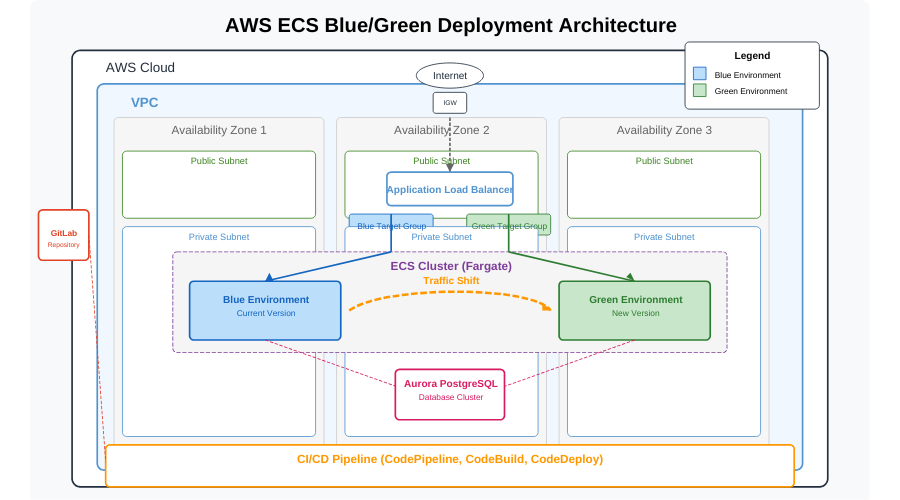Project Demonstration Video
Full Walkthrough
Complete walkthrough of the Blue/Green pipeline, Terraform configuration, and AWS resources
Deployment Flow
Commit Detection
Changes pushed to GitLab trigger the pipeline
Build Phase
CodeBuild compiles the app, packages it into a container, and pushes it to ECR
Deployment Preparation
CodeDeploy creates a new task definition with the updated image
Green Environment Creation
New tasks are deployed to a separate target group
Testing
The new version is verified through the test listener
Traffic Shifting
Production traffic gradually shifts from Blue to Green environment
Cleanup
After successful deployment, the old environment is terminated
Key Challenges & Solutions
I enhanced the KMS key policy to explicitly grant the necessary permissions to the CodePipeline, CodeBuild, and CodeDeploy roles, ensuring proper encryption of artifacts throughout the pipeline.
Rather than using data sources to look up resources that might not exist yet, I updated my module interfaces to accept role ARNs as variables, creating a clear dependency chain between modules.
I implemented a more robust approach using Terraform's yamlencode function to programmatically generate valid YAML, eliminating syntax and escaping issues.
Results & Impact
The pipeline now successfully performs Blue/Green deployments for our Spring Boot application with these benefits:
Users experience no interruption during updates
If an issue is detected, traffic can immediately switch back
New versions are validated before receiving production traffic
All resources are defined in Terraform, enabling consistent environments
The entire process from commit to production requires no manual intervention
Technical Implementation Details
Terraform Structure
I organized the Terraform configuration into modules for better maintainability:
blue-green-ecs-pipeline/ ├── main.tf ├── variables.tf ├── outputs.tf ├── modules/ │ ├── networking/ │ ├── security/ │ ├── database/ │ ├── ecr/ │ ├── load_balancer/ │ ├── ecs/ │ └── codepipeline/
Each module encapsulates a specific part of the infrastructure, with clear interfaces between them.
Key Configuration Insights
The critical part of enabling Blue/Green deployments is properly configuring the load balancer and ECS service:
Creating two target groups (Blue and Green) that the CodeDeploy service can alternate between Setting up the ECS service with a CODE_DEPLOY deployment controller:
resource "aws_ecs_service" "main" {
# Other configurations...
deployment_controller {
type = "CODE_DEPLOY"
}
lifecycle {
ignore_changes = [
task_definition,
load_balancer
]
}
}
Configuring CodeDeploy to manage the traffic shifting:
resource "aws_codedeploy_deployment_group" "main" {
# Other configurations...
deployment_style {
deployment_option = "WITH_TRAFFIC_CONTROL"
deployment_type = "BLUE_GREEN"
}
blue_green_deployment_config {
# Traffic shifting configuration
}
}
Lessons Learned
This project taught me several valuable lessons:
- Infrastructure design matters: Proper segmentation of resources between public and private subnets significantly enhances security
- Dependency management is crucial: Clear resource dependencies in Terraform avoid race conditions and improve reliability
- Proper IAM configuration is essential: Following the principle of least privilege reduces security risks
- Validation before traffic shifting: The Blue/Green approach helps catch issues before they impact users
Future Enhancements
While the current implementation meets our immediate needs, I've identified several potential improvements:
Implement more granular traffic shifting (e.g., 10% increments)
Add integration and load tests during the deployment process
Configure automatic rollbacks based on error rates or latency
Extend the architecture to multiple AWS regions for disaster recovery
Implement auto-scaling for ECS tasks based on demand patterns
